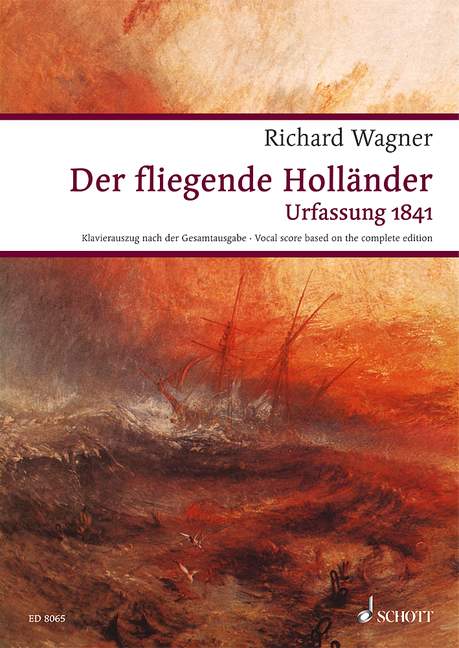Wagner: Der fliegende Holländer, WWV 63
The Flying Dutchman
In stock and typically ships within 1 business day.
- Composer: Richard Wagner (1813-1883)
- Format: Vocal Score
- Instrumentation: Opera
- Work: Der fliegende Holländer (The Flying Dutchman), WWV 63
- Work Languages: English, German
- ISMN:
- Size: 8.3 x 11.7 inches
- Pages: 340
Description
DER FLIEGENDE HOLLÄNDER(Original version)
"With this edition, the original version of Wagner's opera Der fliegende Holländer [The flying Dutchman] WWV 63 is made available to the public for the first time in piano score form. The score on which the edition is based was published in the Richard Wagner-Complete Edition 1983: Richard Wagner. Collected works Volume 4, I-II , The Flying Dutchman. Romantic opera in three acts (original version 1841), edited by Isolde Vetter (Schott Music International, Mainz, RWA 104-10/RWA 104-20)." (Egon Voss, quoted from the foreword of the new Der fliegende Holländer vocal score)
Original version and 1842-1880 version
The original version of Der fliegende Holländer dates from 1841. Wagner, at the time a completely unknown Kapellmeister in France, trying to get a foothold in Paris, saw the opportunity for a stage work that would meet the fashion at the Paris Opera of performing several short works one after another. Der fliegende Holländer , conceived in 1840 and composed in 1841, seemed to him suited to the purpose.
In 1841, even when Wagner no longer counted on a success in Paris, he still held to the conception of a one-act opera and offered the work to German opera houses under the title of "Romantic Opera in One Act and Three Scenes". This version is set in Scotland, taking as the literary model for the opera Heinrich Heine's novel fragment "From the Memoirs of Mr. Schnabelewopski", and the protagonists have English names. This version was never performed in Wagner's lifetime.
Beginning in 1842, the work went through a tale of constant revision: Even before the Dresden premiere (2nd January 1843) Wagner undertook fundamental alterations. He transposed the location from Scotland to Norway, changed character's names as appropriate, divided the opera into three acts – not least due to considerations of scene changes – and transposed Senta's Ballad from in A Minor to G Minor. It was in this version that the score of the opera went to print in 1845.
For a performance in 1860 he composed the later so-called ‘Tristan' or ‘Redemption' ending to the Overture. Until the very end of his life, Wagner contemplated a plan for a final score or a definitive vocal score: it never came to be, so that to this day, as with Tannhäuser, we still do not have Der fliegende Holländer in a final version.
Based on the research conducted in the creation of the Complete Edition, our editions contain, in one case the original version of 1841, while the other essentially goes back to the first printing of the score of 1845, but with the addition of the source material for the retouchings dating from 1842 to 1889.
Publishers use a lot of words to describe what they sell, and we know it can be confusing. We've tried to be as clear as possible to make sure you get exactly what you are looking for. Below are descriptions of the terms that we use to describe the various formats that music often comes in.
Choral Score
A score for vocalists that only contains the vocal lines. The instrumental parts are not there for reference. Generally, cheaper than a vocal score and requires multiple copies for purchase.
Facsimile
Reproductions of the original hand-written scores from the composer.
Full Score
For ensemble music, this indicates that the edition contains all parts on a single system (there are not separate parts for each player). In larger ensembles, this is for the conductor.
Hardcover
Hardbound. Generally either linen-covered or half-leather.
Orchestral Parts
Similar to a wind set, this is a collection of parts. In the case of strings, the numbers listed are the number of copies included, though generally these are available individually (often with minimum quantities required).
Paperback
When publishers offer multiple bindings (e.g. hardcover) or study scores, this is the "standard" version. If you're planning to play the music, this is probably what you want.
Performance / Playing Score
A score of the music containing all parts on one system, intended for players to share. There are not separate parts for each player.
Set of Parts
For ensemble music, this indicates that there are separate individual parts for each player.
Solo Part with Piano Reduction
For solo pieces with orchestra, this is a version that contains a piano reduction of the orchestra parts. For piano pieces, two copies are typically needed for performance.
Study Score
A small (think choral size) copy of the complete score meant for studying, and not playing. They make great add-ons when learning concertos and small chamber works.
Vocal Score
A score prepared for vocalists that includes the piano/organ part or a reduction of the instrumental parts.
Wind Set
For orchestral music, this is a collection of wind and percussion parts. The specific quantities of each instrument are notated.
With Audio
In addition to the printed music, the edition contains recordings of the pieces. This may be an included CD, or access to files on the internet.
With / Without Fingering (Markings)
Some publishers prepare two copies - a pure Urtext edition that includes no fingering (or bowing) suggestions and a lightly edited version that includes a minimal number of editorial markings.


